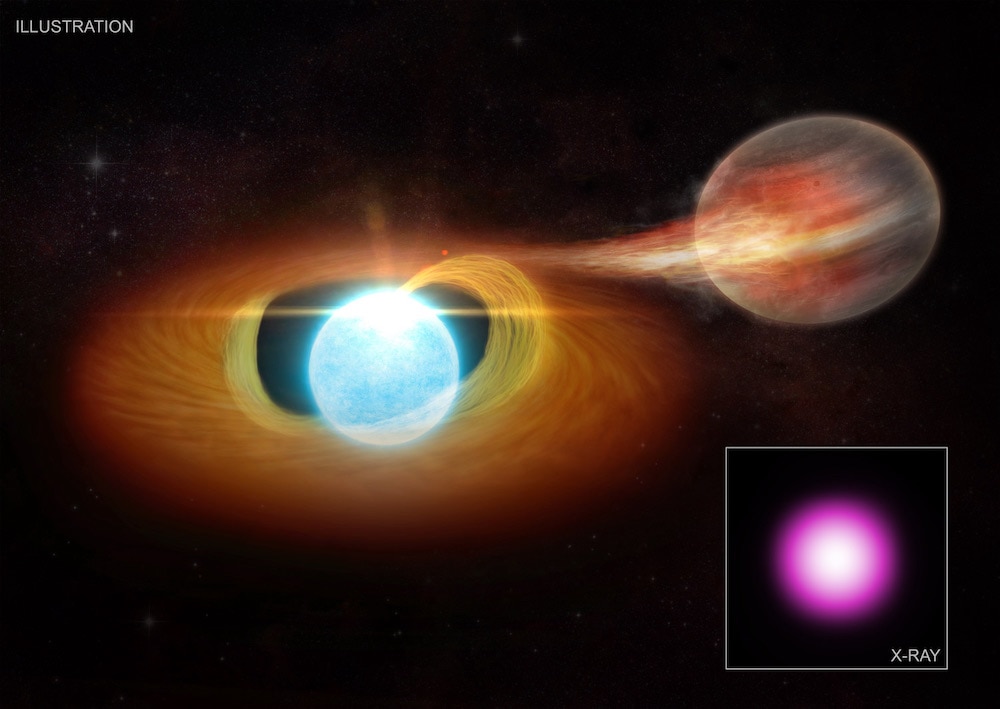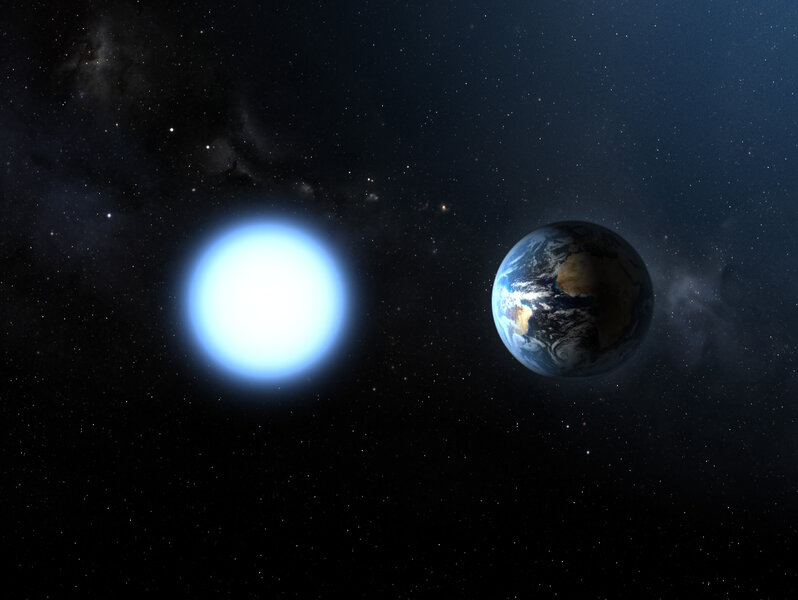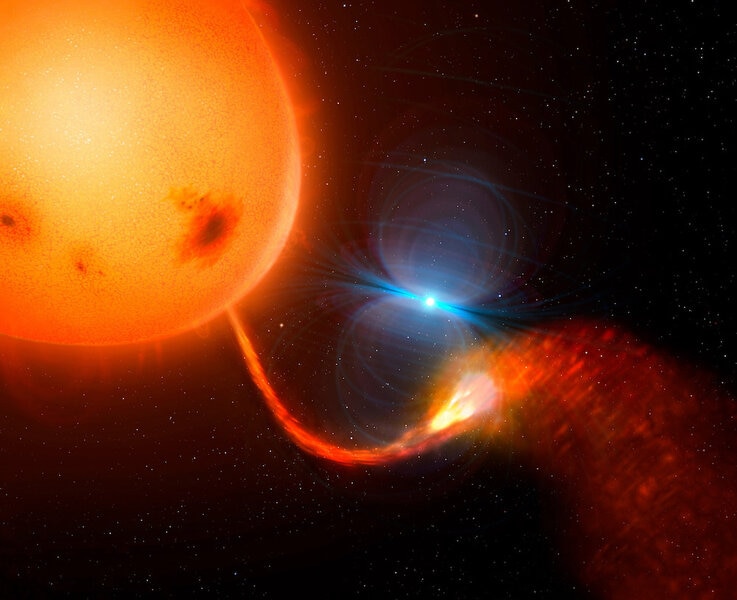Create a free profile to get unlimited access to exclusive videos, sweepstakes, and more!
Two zombie stars are eating their companions and creating cosmic chaos
White dwarfs can eat planets and stars and blast out VAST amounts of energy.

In a fun coincidence — if cosmic mayhem is your idea of fun* — two news stories just came out about zombie white dwarf stars destroying their companions and the ensuing chaos this has caused.
White dwarfs are the exposed cores of stars like the Sun after they run out of fuel to fuse. The star swells up into a red giant, ejects its outer layers over a few hundred million years, and leaves behind the dead core. It has roughly half the mass of the Sun compressed into a ball the size of the Earth (it can be so dense a cubic centimeter of it has a mass of a thousand tons!), and can be extremely hot, up to a couple of hundred thousand degrees Celsius.
... but sometimes they're only mostly dead. If there's a secondary object, a companion of some kind like a star or planet, the intense gravity of the white dwarf — hundreds of thousands of times Earth's gravity — can pull material off that companion and steal it for itself.
And that takes us to Cosmic Mayhem Story #1: The white dwarf LAMOST J024048.51+195226.9 (let's call it J0240 for short) was first seen to be an interesting object in a survey of the sky taken by the Large Sky Area Multi-Object Fibre Spectroscopic Telescope (hence LAMOST). The star brightened and dimmed on a rapid timescale, indicating it's what we call a cataclysmic variable — a white dwarf drawing off material from a companion. That material flow isn't always stable, and can slam down onto the white dwarf at extremely high speed, creating tremendous flares of energy.
The overall brightness of J0240 does wax and wane on an incredibly precise regular schedule of 0.3056849 days (7.33 hours). This is certainly the orbital period of the companion star the white dwarf is eating, which in turn means it's very close to the white dwarf.
The system also shows signs of flinging away hydrogen at extremely high speeds, up to 3,000 kilometers per second: that's ten million kilometers per hour!
It's hard for a white dwarf to do this unless it has a very powerful magnetic field. That can focus the incoming stream of material and accelerate it so hugely it gets shot away from the star. Magnetic fields like this are powered in part by the spin of a white dwarf, and to get a field this powerful the star would have to be spinning extremely rapidly.
So the astronomers used a high-speed camera on the gigantic 10.4-meter Gran Telescopio Canarias to look at J0240, and found it brightens and dims on a rapid timescale, certainly due to hot spots on the surface rotating into and out of view. That's expected, but it's the rate that's staggering: It spins once every 24.93 seconds. That's more than twice per minute.
Mind you, this is an object that has a mass of an octillion tons and is over 10,000 km wide. That rotation speed is phenomenal. At its equator that's a speed of nearly 5 million km/hr!
Only one other star like this is known, AE Aquarii, which is very similar and spins once every 29 seconds, so J0240 is significantly faster. It's a record breaker. Incidentally, stars like this are appropriately nicknamed propeller stars.
How can it spin so fast? Most likely the material falling in from the companion star has spun it up, like using a spoon to stir coffee. At first that material slammed into the white dwarf's equator, spinning it up. That strengthened its magnetic field, which is now so powerful it channels that material onto the white dwarf's poles, much like Earth's magnetic field channels the solar wind to the poles and creates the aurora borealis and australis.
All of this energy is powered by the star's spin, so it slows over time. Eventually it might spin down enough that its field will weaken, and it won't fling material away. However, the companion is losing mass as the zombie star drains it, so it's a race to see which one wins. At the moment, that outcome isn't clear.
So now let's look at Cosmic Mayhem Story #2: This time, it's the white dwarf KPD 0005+5106. Located about 1,300 light years from Earth, observations from the Chandra X-ray Observatory show it's shining brightly in X-rays, which means its magnetic field is doing some high-energy shenanigans as well.
The temperature of this star is about 200,000° C, making it one of the hottest known. The X-rays brighten and dim on a timescale of about 4.7 hours, so it has something orbiting it very close in as well. So close in fact that it can't be a normal star like the Sun; that would be way too big. So it's either an extremely low-mass red dwarf star, a brown dwarf, or a gas giant planet.
We know that many stars have Jupiter-mass planets orbiting very close to them, and when the star turns into a red giant it can engulf the planet, which drops down toward the core and spins the star up. When the outer layers are ejected you're left with a gas giant very close to the white dwarf, and superheated by it. That fits what's seen with KPD 0005+5106, though a brown dwarf or red dwarf can't be excluded.
Whatever the companion is, the white dwarf is tearing it apart and eating it. If it's a planet it may be completely destroyed by the white dwarf in a few million years. We've seen gas giants around white dwarfs before, as well as debris from planets the host star has destroyed.
This precise fate will elude our own Sun, which will become a white dwarf in about 7 billion years. The planets are too far out for it to start sucking down their matter (though it'll eat Mercury, Venus, and maaaaaybe Earth in the process). But for many other stars, such fates are expected. They may not get spun up to dizzying rotational rates like J0240 — stars like that are rare — but such tiny beasts gorging themselves on their children and spewing out high-energy radiation are more common. It's a rough Universe out there.
Tip o' the accretion disk to the artist Mark Garlick for the alert about J0240.
*It is for me.





























